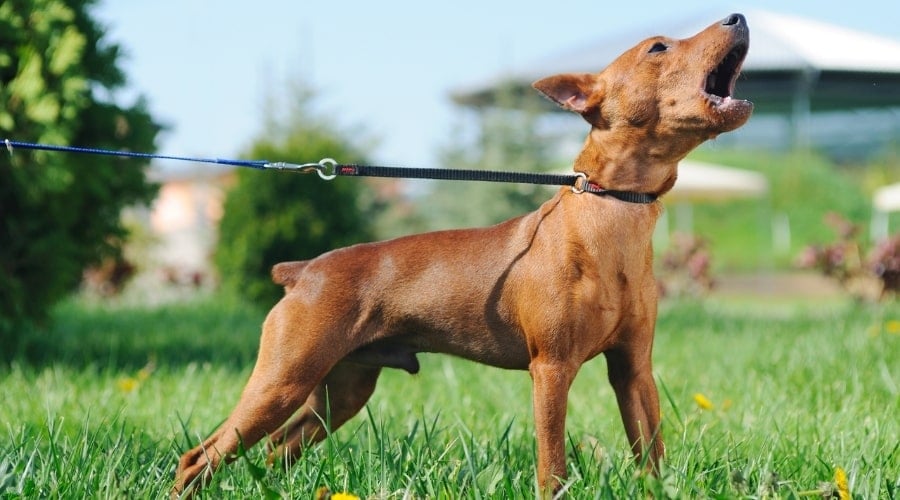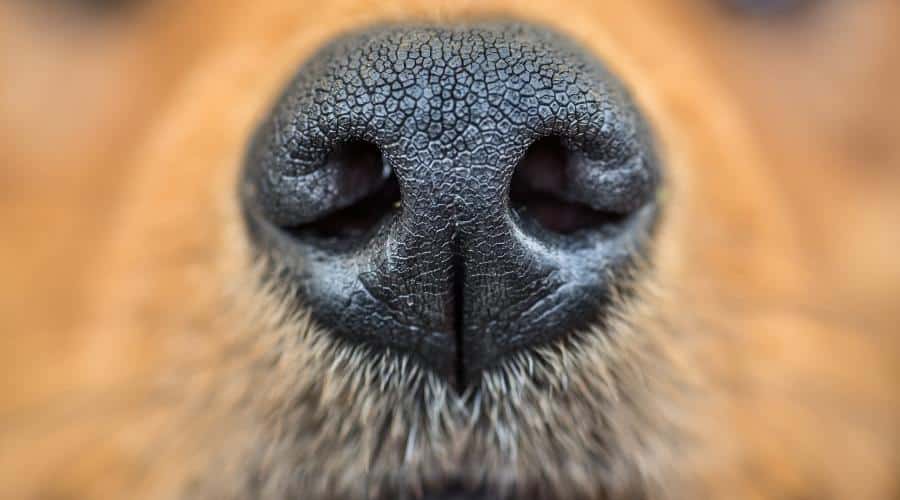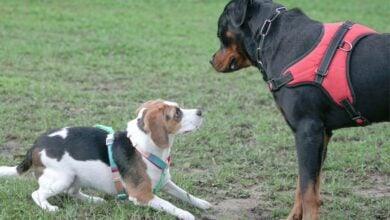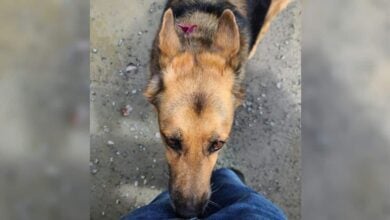When you purchase through links on our site, we may earn a commission. Here’s how it works.
Dealing with a viciously aggressive dog can be overwhelming, but it’s important to remember that aggression is a behavior—not a personality trait. Dogs don’t act aggressively without reason. Their actions are often driven by fear, anxiety, past experiences, or an instinct to protect. While aggression can be concerning, it is manageable with the appropriate aggressive dog training tips.
Table of Contents
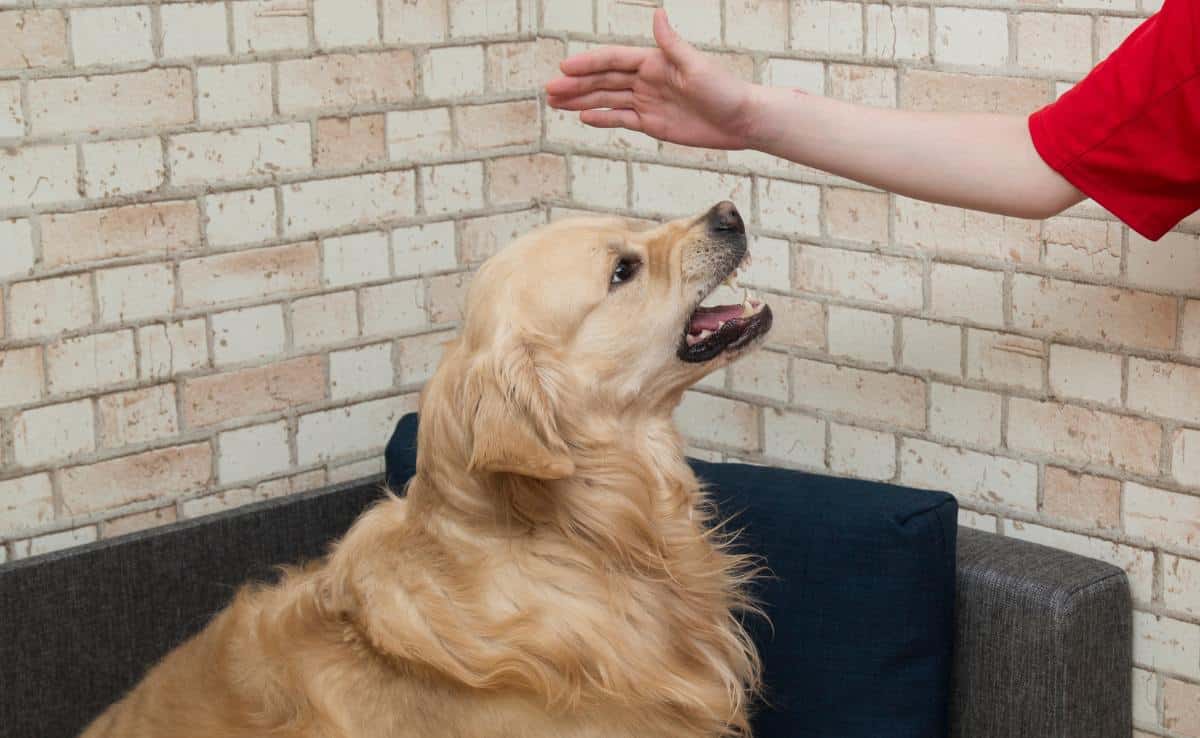
This guide will help you identify the causes of aggression, recognize warning signs, and implement proven training strategies to help your dog become a well-adjusted companion.
Why Are Some Dogs Aggressive?
Dogs can develop aggressive tendencies for a variety of reasons. Understanding the root cause is the first step in addressing the behavior. Some dogs become aggressive due to fear, while others react out of territorial instincts or a desire to protect their owners. Recognizing the specific type of aggression your dog displays is crucial in addressing the issue effectively.
Dominance Aggression
Dominance aggression occurs when a dog attempts to assert control over people or other animals. These dogs may growl, snap, or even bite when asked to move from furniture, when handled, or when corrected.
For example, a dog that growls when their owner tries to take away a toy or refuses to obey commands may be displaying dominance aggression. This behavior requires firm but fair leadership, structured training, and clear boundaries to establish the owner’s authority without resorting to punishment. Consistently enforcing rules and using positive reinforcement to encourage cooperation can help reduce dominant behaviors.
Fear-Based Aggression
Fear is one of the most common causes of sudden aggression in dogs. A dog that feels cornered, overwhelmed, or threatened may lash out as a defensive response. This type of aggression is often seen in rescue dogs with traumatic pasts or dogs that were not properly socialized as puppies.
For example, a fearful dog may growl or snap when approached by a stranger or forced into an uncomfortable situation. Owners should build confidence through controlled exposure and positive reinforcement to manage fear-based aggression. Teaching a dog that unfamiliar situations are safe can help them overcome their fears over time.
Possessive Aggression (Resource Guarding)
Some dogs display aggression when protecting valuable resources like food, toys, or even their favorite person. This behavior, known as resource guarding, is instinctual—dogs in the wild must protect their food and belongings to survive. A dog that growls when someone approaches their food bowl or snaps when another pet gets too close to their favorite toy shows possessive aggression.
The best way to manage this behavior is by teaching trade commands and rewarding the dog for voluntarily giving up possessions rather than reacting aggressively. Gradual desensitization exercises—such as hand-feeding or offering high-value treats in exchange for guarded items—can help a dog learn to trust their owner around their resources.
How To Teach Your Dog To Trade
To teach the trade command, start by offering your dog a low-value item, such as a toy. Once they take it, present a high-value reward (like a favorite treat) and say “trade” in a calm, upbeat tone. When your dog drops the toy to take the treat, immediately reward them. Repeat this process, gradually increasing the value of the item they’re holding. Over time, your dog will learn that releasing an item on command leads to a better reward, reducing resource-guarding behaviors and reinforcing positive interactions.
Protective Aggression
Protective aggression is similar to territorial aggression but focuses on guarding people rather than space. Some dogs are instinctively more protective of their owners and family members. This behavior is also common in mother dogs protecting their puppies.
For instance, a dog may bark and growl at strangers approaching their owner, even if there is no real threat. This can become problematic if the dog starts reacting aggressively in harmless situations.
Teaching the dog to differentiate between real and perceived threats through proper training and exposure can help reduce unnecessary protective aggression. Controlled introductions to new people and experiences can build their confidence and reduce reactive behaviors.
Sexual Aggression
Unneutered dogs can become highly competitive during mating, often viewing other dogs as rivals. This competition can lead to aggressive behaviors such as growling, snapping, or even physical confrontations. Instinct-driven, this type of aggression is primarily triggered by the presence of other dogs and the desire to establish dominance.
While this behavior is most commonly seen in unneutered males, females may also exhibit aggression when competing for a mate. Spaying or neutering can significantly reduce hormone-driven aggression, but some dogs may continue to display territorial or dominance-related behaviors that require training and management.
Dogs can develop aggressive tendencies for a variety of reasons. Understanding the root cause is the first step in addressing the behavior. Some dogs become aggressive due to fear, while others react out of territorial instincts or a desire to protect their owners. Recognizing the specific type of aggression your dog displays is crucial in addressing the issue effectively.
Territorial Aggression
Dogs are naturally protective of their space, but some take it to an extreme. Territorial aggression occurs when a dog perceives a person or animal entering their home or yard as a threat. This can manifest as barking, growling, lunging, or even biting.
For example, a dog that aggressively guards the front door and reacts strongly to delivery workers may display territorial aggression. Controlled socialization and desensitization exercises can help the dog learn that visitors are not dangerous. Rewarding calm behavior when someone approaches the home can reinforce positive responses rather than aggression.
Signs Of Aggressive Behavior
If you pay attention, you may notice some warning signs that your dog is getting aggressive before his behavior becomes serious. Sometimes, these behaviors follow an escalating progression, as listed below.
- Aggressive eye contact
- Baring teeth
- Biting
- Ears pinned back
- Fast pacing
- Growling, snarling, or barking
- Lunging toward the person or other animal
- Muzzle punch, which involves the dog hitting you or others with their nose
- Snapping
- Tail between legs
- Tense or rigid posture
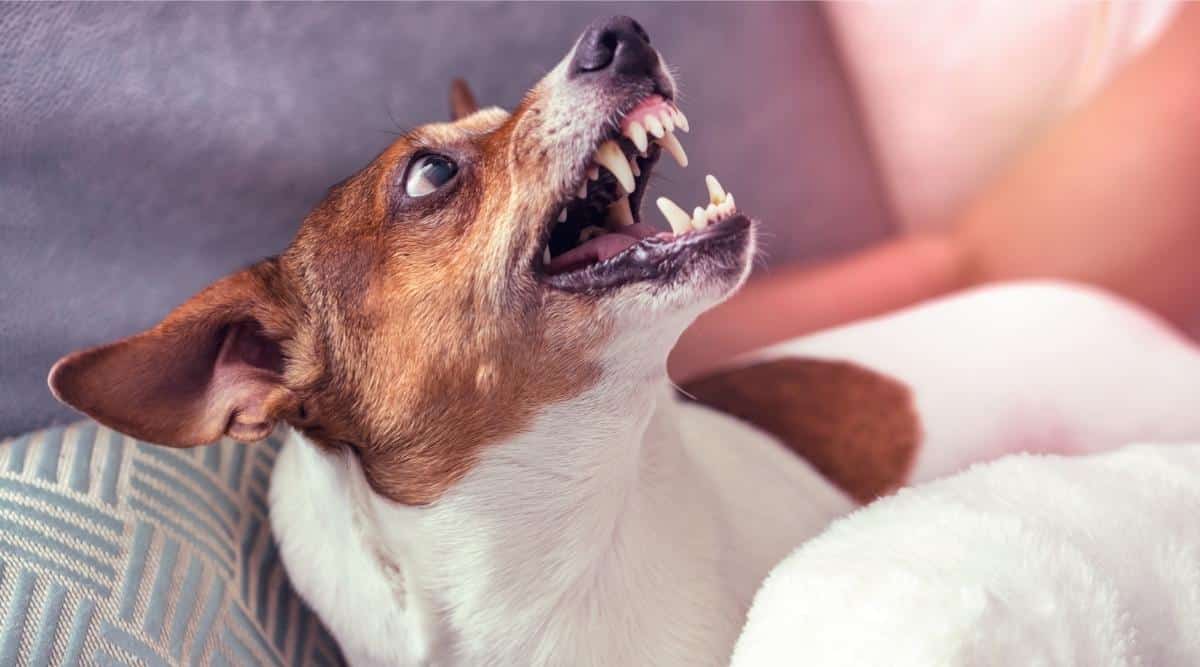
Warning Signs That Aggression Is Coming
An owner who fails to see the signs of aggression as they develop will soon find themselves with a completely out-of-control dog. Recognizing early signs of aggression can help prevent a situation from getting worse.
- Avoidance behaviors: Turning away, walking off, or looking away when approached
- Destructive behavior: Digging, chewing, or ripping apart objects
- Increased tension: Stiff body posture, tight mouth, and ears pinned back
- Stress signals: Excessive yawning, lip licking, or sudden scratching
- Whining or low growling: A dog may start with quiet vocal warnings before escalating
Understanding Your Dog’s Triggers
Aggression isn’t random. Every aggressive outburst has a trigger—something that provokes a dog to react. Identifying these triggers is key to managing and reducing aggression.
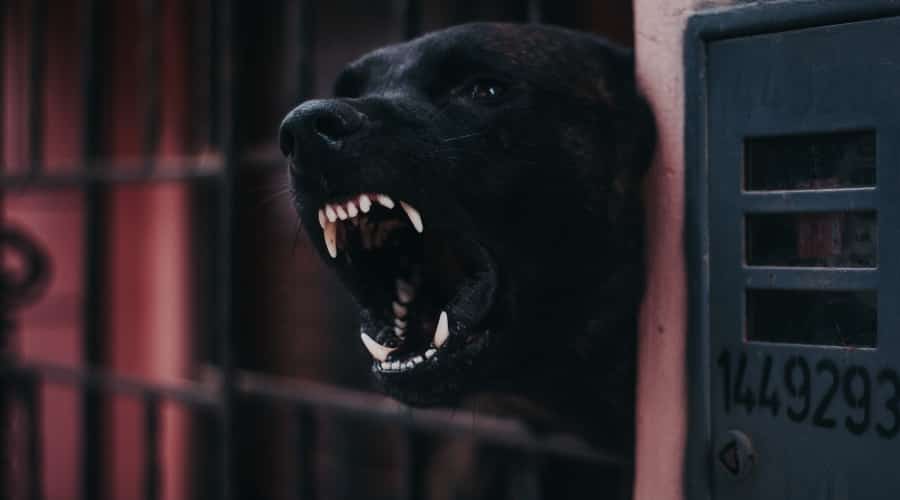
Common Triggers
Dogs can become aggressive in response to various stimuli. The most common triggers include:
- Pain or discomfort – Medical conditions like arthritis, hip dysplasia, or dental pain can cause a dog to snap when touched.
- Past trauma or neglect – Rescue dogs with a history of abuse may react aggressively in stressful situations.
- Loud noises – Thunder, fireworks, and even vacuum cleaners can startle dogs, leading to fear aggression.
- Unfamiliar people or animals – Lack of early socialization can make dogs react aggressively to strangers or other pets.
How To Identify Your Dog’s Triggers
To successfully manage aggression, you need to pinpoint what sets your dog off. Try the following strategies:
- Keep a behavioral log – Write down when and where aggressive incidents happen. Are they related to specific objects, people, or locations?
- Observe subtle body language – Dogs show signs like licking lips, yawning, or avoiding eye contact before aggression escalates.
- Gradual exposure to triggers – If safe, slowly introduce your dog to stressful situations while monitoring their reaction.
Next Steps
Once you’ve identified your dog’s triggers, you can create a training plan to desensitize them over time. Positive reinforcement and controlled exposure can help your dog feel safer in previously stressful situations.
How To Train A Dog To Be Less Aggressive
Training an aggressive dog requires patience, consistency, and a structured approach. Aggressive training for dogs is essential for those who exhibit vicious behavior.
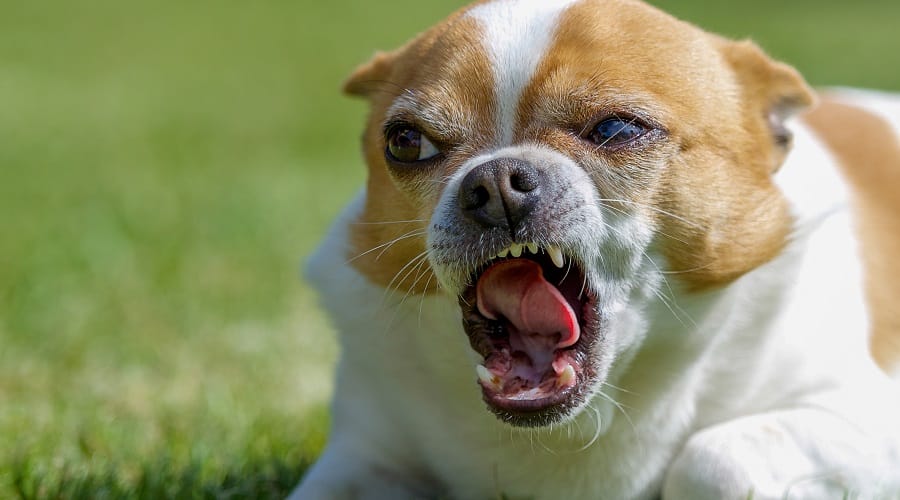
The goal is to replace aggressive responses with positive behaviors while helping your dog feel more secure in stressful situations.
Key Training Methods
- Use Positive reinforcement – Reward-based training is the most effective way to reshape behavior. Praise and treat your dog for calm reactions in situations where they would typically be aggressive.
- Teach basic obedience commands – Commands like “sit,” “stay,” “leave it,” and “come” give your dog structure and help establish your leadership.
- Avoid punishment – Harsh corrections, yelling, or physical punishment can worsen aggression by increasing fear and anxiety. Instead, focus on redirecting negative behavior.
- Desensitize and countercondition – Gradually expose your dog to their triggers in a controlled environment while rewarding calm behavior to help them associate triggers with positive experiences.
- Maintain consistency and routine – Dogs thrive on structure. Keeping training sessions regular and predictable helps build confidence and reduce stress-related aggression.
Consider Professional Training
Training a vicious dog is no easy feat. That’s why working with a certified dog trainer or animal behaviorist can be beneficial if your dog’s aggression is severe or persistent. They can create a personalized training plan and safely guide you through the process.
A structured training program and a patient, consistent approach can help even the most aggressive dogs become calmer and more well-adjusted.
How To Find A Good Trainer
If you don’t know any dog trainers in your area, be sure to ask your friends and neighbors. Your veterinarian can also give you some recommendations. Local vets deal with questions about aggressive dogs all the time, so they’ll know where to steer you. And see our tips on how to find the best dog trainer for you and your pup.
When To Seek Veterinary Help
Sometimes, aggression isn’t just a behavioral issue—it can be a sign of an underlying medical condition. A veterinary checkup is essential if your dog suddenly becomes aggressive or their behavior changes drastically.
Medical Conditions That Can Cause Aggression
Several health issues can contribute to aggressive behavior, including:
- Pain – Dogs in pain may lash out when touched, especially if they have arthritis, dental disease, or an injury.
- Neurological disorders – Conditions such as brain tumors, epilepsy, or cognitive dysfunction can lead to uncharacteristic aggression.
- Thyroid imbalances – Hypothyroidism has been linked to increased irritability and aggression in dogs.
Signs Your Dog May Have A Health-Related Issue
If your dog’s aggression is sudden or uncharacteristic, look for additional warning signs, such as:
- Changes in appetite or energy levels
- Increased irritability or restlessness
- Limping or favoring one side of the body
- Reluctance to be touched or groomed
- Unexplained whining or vocalization
How A Veterinarian Can Help
A veterinarian will perform a complete physical exam and may recommend blood work, neurological tests, or imaging (such as X-rays) to identify any underlying medical conditions. If a medical issue is found, treatment options may include pain management (e.g., massage, physical therapy), medication, or specialized care to address the root cause of aggression.
Seeking veterinary care ensures that aggression isn’t driven by pain or illness, allowing for a more effective behavior modification plan.
Socialization Strategies For Aggressive Dogs
Proper socialization is one of the most effective ways to reduce dog aggression. When done correctly, it helps them feel comfortable around new people, animals, and environments. However, aggressive dogs require careful and controlled socialization to ensure safety and positive experiences.

Safe Ways To Introduce Your Dog To New People & Animals
- Start with distance – Allow your dog to observe new people or animals from afar before gradually decreasing the space between them.
- Let your dog set the pace – Never force an interaction. Allow your dog to approach new people or animals when they feel ready.
- Use positive reinforcement – Reward calm behavior with treats and praise, reinforcing that meeting new individuals is a good experience.
- Avoid overwhelming situations – Large crowds, loud noises, or chaotic settings can make socialization stressful for an aggressive dog.
The Role Of Controlled Environments In Socialization
A structured environment provides a safe space for your dog to learn appropriate behaviors. Controlled settings include:
- Obedience classes with trained professionals – Allow dogs to learn in a structured group setting while under expert supervision.
- Neutral territory introductions – Meeting new dogs in a neutral environment (like a park) can prevent territorial aggression.
- One-on-one introductions – Instead of overwhelming your dog with multiple new experiences at once, gradually introduce them to new people or animals.
Using Gradual Exposure Techniques To Reduce Fear-Based Aggression
For dogs with fear-based aggression, slow and steady exposure is key. Follow these steps:
- Identify the triggers – Determine what situations or types of people/animals make your dog uncomfortable.
- Introduce triggers at a low intensity – For example, if your dog reacts to strangers, start by having them observe a new person from a distance where they remain calm.
- Pair the experience with rewards – Give treats and praise when your dog remains relaxed around the trigger.
- Increase exposure gradually – Slowly close the distance over time, ensuring your dog stays below their stress threshold.
With patience and consistency, socialization can significantly reduce aggressive tendencies and help dogs build confidence in new situations.
Aggressive Training for Aggressive Dogs: Why a Strong Approach Works Best
At least at first, aggressive dog behavior training is best left up to expert trainers because the causes and behaviors can vary so much. Ultimately, it’s in your best interest to consult an expert before you try training your dog yourself—especially if you think your dog could harm someone.
If you can’t afford professional training hours, you should at least consider one or two sessions so a professional can give you specific tips on how to proceed on your own. This helps you understand how to train an aggressive dog and protects you and your dog from major troubles down the road.
Another option is to sign up for an affordable online dog training course, like SpiritDog Traning, that can run you through many issues you’re facing and give you actionable steps to correct your dog’s negative behavior.
Myth-Busting: Common Misconceptions About Aggression
There are many myths surrounding aggressive dogs that can lead to misunderstandings and improper handling. Let’s uncover the most common misconceptions and uncover the truth.

“Aggressive Dogs Can’t Be Trained”
Many people assume that dogs are beyond help when they show aggressive behavior. This is far from the truth. Aggressive dogs require aggressive training—but not in the way you think. It’s all about consistent training, ample patience, and positive reinforcement.
Most aggressive dogs can learn to manage their triggers and react in a more controlled manner. Aggression is a behavior, not a permanent trait, and it can be modified with the right approach.
“Some Breeds Are Just Naturally Mean”
Aggression is not a default trait of any breed. That being said, some breeds are naturally more prone to aggressive tendencies.
One study looking at breed differences in canine aggression found that the prevalence, severity, and targets of aggression varied considerably between breeds:
- Chihuahuas, Dachshunds, and Jack Russell Terriers were most likely to display severe aggression towards humans (owners and strangers).
- More than 20% of Akitas, Jack Russell Terriers, and Pit Bull Terriers were reported to display severe dog-on-dog aggression when introduced to unfamiliar dogs.
- Golden Retrievers, Labradors Retrievers, Bernese Mountain Dogs, Brittany Spaniels, Greyhounds and Whippets were the least aggressive toward both humans and dogs.
While research suggests that some dogs may be genetically more susceptible to aggression when experiencing fear and stress, a dog’s behavior is shaped more by training, environment, and socialization. Any dog can be well-behaved with proper care and training.
“Punishment Is the Best Way to Stop Aggression”
Punishing an aggressive dog often does more harm than good. Yelling, hitting, or using aversive training tools can increase fear and anxiety, which may worsen aggressive behavior. Instead, focusing on reward-based training, desensitization, and counterconditioning will create lasting behavioral changes and a stronger bond between the dog and owner.
“Once a Dog Bites, They Will Always Be Dangerous”
A single bite does not mean a dog is permanently aggressive or unsafe. Dogs bite for many reasons—fear, pain, stress, or a momentary lapse in judgment. By identifying the cause, working on training, and providing the proper guidance, many dogs can recover from a biting incident and go on to be well-adjusted pets.
Tools To Help With Dog Aggression
Managing aggression often requires the right tools to aid training and ensure safety. While no tool is a complete solution on its own, it can be a valuable aid when used correctly alongside proper training methods.
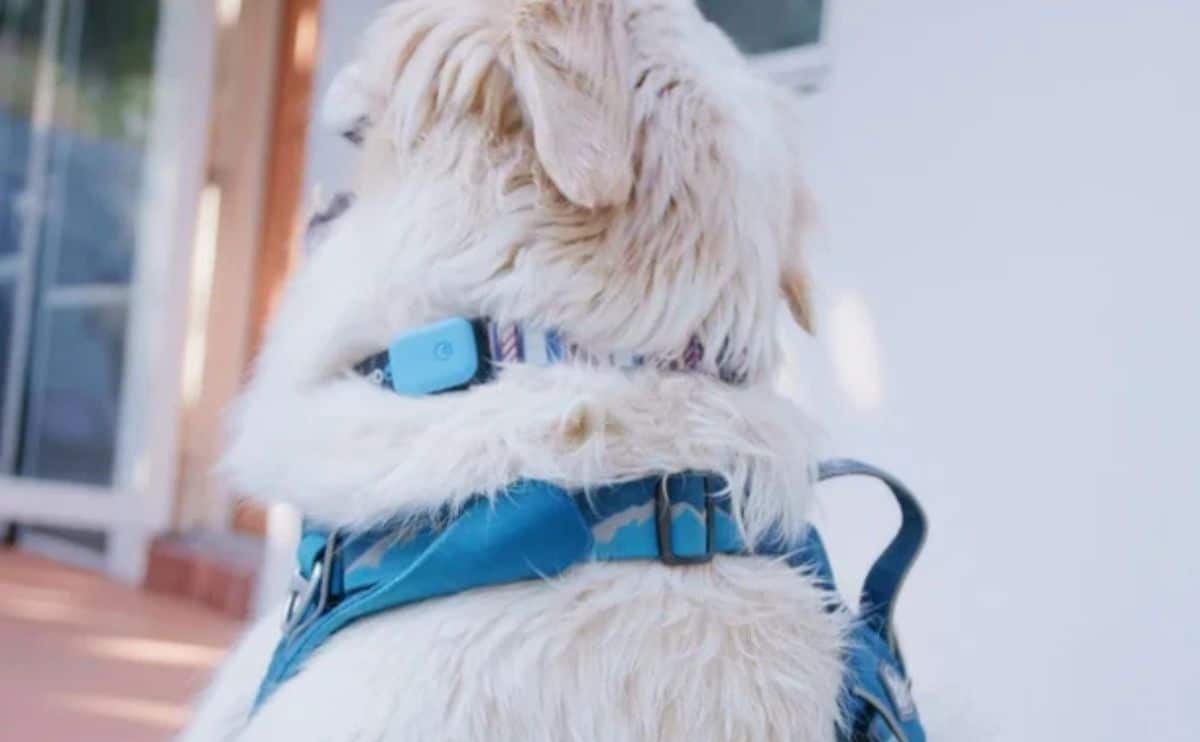
E-Collars: A Controversial But Effective Training Tool
E-Collars, also known as remote training or shock collars, can be helpful when used correctly and humanely. They provide adjustable levels of stimulation to get a dog’s attention and discourage aggressive behavior. However, improper use can lead to fear and increased aggression.
When using an e-collar, it is essential to:
- Use the lowest effective setting – Avoid unnecessarily high stimulation levels that may cause distress.
- Pair it with positive reinforcement – Combine e-collar corrections with treats and praise to create a balanced training approach.
- Seek professional guidance – A certified trainer can help ensure the collar is used correctly and effectively.
E-collars should never be used as a punishment but rather as a communication tool to reinforce desired behaviors and redirect aggressive tendencies.
Prong Collars: Providing Pressure-Based Guidance
Prong or pinch collars can be a useful training tool for certain dogs but must be used correctly. When improperly fitted or misused, they can cause pain and fear, leading to increased aggression. However, under the guidance of an experienced trainer, prong collars can provide gentle pressure feedback to help correct unwanted behavior.
We recommend the Coastal Easy-On Dog Prong Training Collar. Learn more about pinch collars and how to properly fit and use them beforehand to avoid injury and doing more damage than good.
Front-Clip Harnesses: Better Control During Walks
Front-clip harnesses are an excellent alternative to traditional collars, especially for dogs that tend to pull. By attaching the leash at the front of the chest rather than the back, these harnesses gently redirect the dog’s movement, preventing lunging or pulling. This can be especially helpful for managing reactive dogs during walks.
Head Collars (Gentle Leaders): Redirecting Focus
Head collars, such as the Gentle Leader, provide control over a dog’s head movements without causing harm. When used correctly, they help redirect a dog’s attention away from triggers and back to the handler. This tool is useful for dogs that fixate on other animals, people, or distractions.
Basket Muzzles: A Safety Tool, Not A Punishment
A basket muzzle is an excellent option for dogs that may bite when stressed or overwhelmed. Unlike restrictive muzzles, a well-fitted basket muzzle allows dogs to pant, drink water, and take treats while preventing bites.
Muzzles should always be introduced positively, with rewards and gradual training, to avoid creating fear or stress. Learn more about muzzles, including our top picks.
Long Training Leads: Controlled Exposure to Triggers
A long training lead allows a dog to explore their environment while maintaining control from a safe distance. These leads are especially useful for desensitization training, helping aggressive dogs gradually adjust to triggers without feeling confined or threatened.
This video shows the various ways you can use a long line with your dog.
Calming Aids: Reducing Anxiety In Aggressive Dogs
Some dogs may benefit from calming aids, which help reduce stress and lower reactive responses. Options include:
- Anxiety wraps (e.g., ThunderShirt) – Apply gentle pressure, similar to a hug, to promote relaxation.
- Calming supplements – Ingredients like chamomile, valerian root, or CBD can support relaxation in highly anxious dogs.
- Relaxing sprays – Pheromone or essential oil sprays use calming scents to soothe anxious dogs.
Treats & Patience Are Critical To Success
No training tool is more powerful than positive reinforcement. High-value treats, praise, and patience encourage calm behavior and build trust between dog and owner. Consistency and repetition are key—rewarding the right behaviors over time will help reshape aggressive tendencies into positive interactions.
Using the right combination of training tools and behavioral strategies will set your dog up for long-term success.
Expert Guidance: Learn From Doggy Dan’s Proven Methods
Training an aggressive dog can be challenging, and professional guidance can make a significant difference. Doggy Dan’s online training program offers structured, expert-backed methods that have helped thousands of dog owners successfully manage aggression.
Why Professional Online Training Can Be Effective
- Convenience – Learn at your own pace, from the comfort of your home, without the pressure of in-person classes.
- Proven methods – Doggy Dan’s techniques are based on positive reinforcement and behavioral science, making them both humane and effective.
- Step-by-step guidance – Online courses provide structured lessons, ensuring dog owners have a clear roadmap.
Doggy Dan’s Approach To Positive Reinforcement Training
Doggy Dan emphasizes trust-based, reward-driven training rather than punishment or force. His approach includes:
- Understanding your dog’s mindset – Learning why aggression occurs and how to change unwanted behaviors at the root cause.
- Building calm and controlled behavior – Teaching impulse control and rewarding positive actions to reduce aggressive reactions.
- Addressing triggers safely – Using desensitization and counterconditioning to help dogs respond better to stressful situations.
Get Step-By-Step Guidance Today
For dog owners struggling with aggression issues, Doggy Dan’s training program provides expert strategies that can make a real difference.
Frequently Asked Questions
If you’re dealing with an aggressive dog, you likely have many concerns. Below are some of the most commonly asked questions about managing and training aggressive dogs, along with expert-backed answers to help guide you. Don’t see yours? Ask us in the comments!
Can Aggression In Dogs Be Completely Cured?
Aggression is manageable, but it may not always be ultimately “cured.” Aggressive dog training aims to reduce aggressive reactions and replace them with more positive behaviors. With consistency, proper training, and socialization, most dogs can learn to control their impulses and respond calmly to triggers.
Should I Punish My Dog For Aggressive Behavior?
No, punishment can make aggression worse by increasing fear and anxiety. Remember: train aggressively, not harshly.
Instead of punishment, use positive reinforcement to encourage good behavior. Rewarding calm reactions and teaching alternative behaviors (like sitting instead of lunging) is far more effective in modifying aggression.
Can Neutering Or Spaying Reduce Aggression?
Spaying and neutering can help reduce certain types of aggression, particularly those influenced by hormones, such as territorial or dominance aggression. However, not all aggression is hormone-related. Training and behavior modification are still necessary to address the root causes of aggression.
What Should I Do If My Dog Bites Someone?
If your dog bites someone, stay calm and assess the situation. Secure your dog in a safe space, provide medical attention if needed, and exchange contact information with the individual. Consulting a professional trainer or behaviorist after a bite incident is highly recommended to prevent future incidents and work on behavior correction.
Is Professional Training Necessary For An Aggressive Dog?
While some owners can manage mild aggression with proper training techniques, professional training is highly recommended for dogs with severe aggression. A certified behaviorist or trainer can develop a customized training plan and provide expert guidance to ensure safe and effective behavior modification.
Take the First Step Toward a Calmer, Happier Dog
Aggression doesn’t have to define your dog’s behavior. With patience, consistency, and the right training approach, you can help your dog develop better responses and build trust. Training takes time, but every small step you take will contribute to long-term success
Start implementing the strategies in this guide and observe how your dog responds. If aggression persists, seek guidance from a certified trainer or veterinarian to ensure your dog gets the specialized help they need. For expert-led, step-by-step training, explore Doggy Dan’s Training Program and gain the tools to create a more balanced and well-behaved companion.
Why Trust Canine Journal?
Sally has over 20 years of experience in human health sciences communications, including more than 10 years as an expert on pet health conditions and treatment. She’s part of a team of dedicated canine professionals and long-time dog owners at Canine Journal. We test and research the best pet products, not only for our own pups but for all of our readers.
